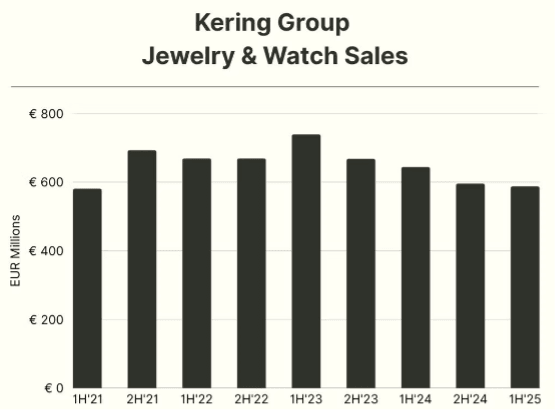I have at times been called a bit of a doomsday specialist when it comes to my coverage of the diamond market. And, honestly, I’ve had that thought about myself, too.
But two seemingly opposing ideas can both be true. I see real value and opportunity in diamonds. At the same time, as a journalist, I report what I see. And right now, it’s hard to ignore the systemic challenges facing the diamond world. The industry is undergoing a major shift in how it operates and in its engagement with consumers.
What sets my perspective apart is that I don’t believe these challenges are new or driven solely by the rise of synthetics. They’ve been building over the past two decades, if not longer.
We don’t have space here to get into all of that, but the depth of the current crisis is clear in the latest earnings reports from mining companies, luxury houses, and retail jewelers. Our July 2025 News Roundup shows just how broad and consistent the declines are, albeit with a handful of exceptions.
It also helps put Anglo American’s plan to exit De Beers – and, by default the diamond category – into context, especially considering Anglo’s strategy to unlock value across its portfolio. CEO Duncan Wanblad put it plainly in last week’s half-year earnings call: “Primarily due to the complexity of the shareholding arrangements and more importantly the challenging diamond markets over the last couple of years, this [De Beers sale] was always expected to be the final step on the portfolio transformation journey.”
I try to understand the deeper message behind that sentiment and unpack the De Beers earnings in my latest ‘Diamond Minute’ video. You can watch it here: The Real News Behind De Beers $303M Loss.
Now, for the Pressing Matters at hand…
>>> Botswana Health Cuts Reveal Cost of Diamond Slump
Botswana’s Ministry of Health issued a worrying statement today, stressing that “due to the ongoing financial challenges facing the country, that have left the country’s medicines and medical commodities’ situation strained, the ministry has had to streamline some health services and prioritize saving lives over everything else.”
You can read the full message here. It’s a stark reminder of just how deeply diamonds are embedded in Botswana’s economy.
Diamonds account for roughly 80% of Botswana’s exports and have historically enabled the government to offer free education and healthcare to all its citizens. So, when the diamond market slumps, as it has over the past two years, government revenues tighten, affecting its ability to carry out those services. (See editorial: Botswana’s Diamond Obsession).
We often hear the phrase “Diamonds Do Good” and sometimes dismiss it as feel-good marketing. But I’d argue it’s more than just a slogan — it’s a reality. This market downturn has serious consequences, not just for Batswana (Botswana citizens), but for the tens of thousands of workers in Surat whose livelihoods depend on natural diamond demand, and the even larger numbers in the artisanal mining sector around the world, among many other examples.
The initially proposed 37% tariff on US imports from Botswana would have been devastating — a nail in the coffin for the country's diamond industry. Thankfully, reason won out and the final rate was lowered to 15%.
What the trade ultimately needs regarding the tariffs is a level playing field. The World Diamond Council is lobbying to have diamonds added to the list of tariff-exempt products. The US administration is reportedly prioritizing country-level negotiations before addressing individual industry appeals — so whether this effort succeeds remains to be seen.
In the meantime, it is important for the global trade that Botswana maintains its competitive edge.
View the full list of reciprocal tariff rates, updated on July 31, here: Further Modifying The Reciprocal Tariff Rates.

>>> Kering Group often flies under the radar when it comes to reporting jewelry sales. That’s partly because it doesn’t operate at the same scale in this space as its fellow luxury conglomerates Richemont or LVMH, but also because it lumps jewelry into its broader “Other Houses” division — home to fashion brands like Balenciaga and Alexander McQueen.
Still, Kering gave a small nod to the category in its first-half earnings, noting that “sales remained solid at the jewelry houses.” These include Boucheron, Pomellato, DoDo, and Qeelin.
Digging deeper, the report reveals that jewelry and watches made up 32% of sales within the “Other Houses” division, and 4% of revenue at Gucci, which is reported separately. By my calculations, jewelry and watch sales declined 3% year-on-year across the “Other Houses”, and 26% at Gucci. That brings the group’s total jewelry and watch sales to EUR 588 million ($680 million) for the half year, down 9% from the same period last year.
Coming Up
• Melee The Show (New York) – August 3 to 5
• Brilliant Earth 2Q results – August 7
• Lucara Diamond Corp. 2Q results – August 8
• Gem Diamonds 2Q results – TBD

Image: Shri Rahul Narvekar, Speaker of the Maharashtra State Legislative Assembly, inaugurates the India International Jewellery Show (IIJS) which took place in Mumbai over the weekend. (Credit: Gem & Jewellery Export Promotion Council).
